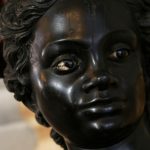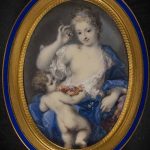The library of San Francesco della Vigna in Venice is a true jewel. In a city where many libraries are fascinating, such as the Marciana National Library or the Querini Stampalia library or the one at the Giorgio Cini Foundation, what is it that makes the library of San Francesco della Vigna worthwhile visiting?
The Institute of Ecumenic Studies “San Bernardino”
The library of San Francesco della Vigna is connected to the Institute of Ecumenic Studies “San Bernardino”, as part of the Pontificia Università Antonianum. While the major centre is in Rome, other sites are located in Jerusalem, Murcia and Venice. Promoting ecumenism and inter religious dialogue, the Franciscan Minor Friars’s library in Venice features collections of ancient manuscripts, printed books and incunabula, polyglot bibles, chorals and much more. When exploring the library, you will notice the provenance of many items from several other library funds, no longer active. A very important one came from the lagoon island of San Michele.
The cloisters and its vineyard introduce you to such wonders and the care the librarian Brother Rino Sgarbossa puts in displaying some pieces helps you understand the history of printing in Venice in the early years.
Venice as the capital of the printing industry
Capital of the printing industry in the 15th and 16th century, Venice was the city where Aldus Manutius invented italics and added punctuation to books, where Daniel Bomberg printed both the first Babylonian Talmud and the Jerusalem Talmud in Hebrew, where Ottaviano Petrucci printed the first music scores. In the library of San Francesco della Vigna you can also see the development from manuscripts to printed editions, from hand-painted miniatures to the use of copper plates and woodcuts for illustrations.
A short story of the collection in the library of San Francesco della Vigna
A fundamental impulse to become an important library was given in 1437 by Pope Eugene IV who ordered not to disperse the libraries of the friars after they passed away. Soon, in the 1500s, Jacopo Sansovino and then Andrea Palladio rebuilt the church of this Venetian monastery in a more prestigious temple with the support of aristocratic families of the kind of the Gritti or the Grimani.
Unfortunately the library was suppressed by Napoleonic edicts. Its collection was dispersed as it happened to all the monastic libraries in the Republic of the Doges. But starting in the early 1880s, a new library was reborn like a phoenix out of its own ashes, getting to the current considerable collection of over 45,000 ancient books (not to mention the modern ones).
The chorals in the library of San Francesco della Vigna
One of the rooms I love particularly is the one where chorals are exhibited. They rest in a dark room, beautifully preserved in the correct humidity/temperature conditions. When lights are turned on, you see hand-written and printed chorals, ranging from the late 15th century till the 18th century. The few miniatures in gold, red lead, brilliant blue in lapis lazuli, need a lens to be enjoyed in all their precious details. Over 15 kg heavy, each choral is enveloped in a thick leather and metal cover, with its latches.
The musical notes in black placed on the red lines of the pentagram are large enough to be read from afar in the choir stalls of the church. You can almost hear the Gregorian chants and see the friars while elevating their voices to God.
Polyglot bibles of the 16th century
Another part of the collection of the library of San Francesco della Vigna consists of polyglot bibles printed in the 16th century. One I love was printed in Antwerp, in the Flanders. Originally written in Hebrew, the Bible displays the Greek translation of the text in Hebrew, the Latin translation of the Hebrew and the Latin translation of the Greek, with a bottom text in Aramaic or Chaldean.

The different languages: Polyglot Bible, Antwerp, Christophe Plantin, 1570-1572, San Francesco della Vigna library, Venice
As you know religious texts need to be studied in their original language and when translations are given, it is essential to be able to compare and see where the original words and the translated ones differ or resemble. As a graduate in foreign languages, it feels particularly touching and fascinating to me to see such books as they really embody the intricacy of multi-religious discourse and its meaningful silences in between the words.

Illustrations of Polyglot Bible, Antwerp, Christophe Plantin, 1570-1572, San Francesco della Vigna library, Venice
Holy cards: a temporary exhibition at the library of San Francesco della Vigna in Venice
In the library of San Francesco della Vigna you may also see temporary exhibitions highlighting some funds. At the moment I am writing there is an extraordinary exhibit regarding holy cards. In Italian they are called “immaginette” or “santini”. In the exhibit you will see some linked to Christmas motifs.
These holy cards are part of the fund originally belonging to Friar Anacleto Sasso, who died in 1998. The collection amounts to around 30,000 pieces, some dating back to the 17th century.
The 800th anniversary of the crib in Greccio by St Francis
As Christmas is approaching, it is quite interesting to observe these “portable” Christmas cribs. Usually carefully kept in your pockets, in the drawer next to your bed, in your purse, these holy cards could not but be exhibited this year. This year as a matter of fact, one celebrated the 800th anniversary of that first nativity crib created by St Francis in Greccio, near the city of Rieti in 1223, a little “borgo” in Italy, just as if it were Bethlehem. The scene was also represented by Giotto in the basilica in Assisi.
Vernacular religion in the holy cards
Far from being just ephemera or ordinary objects, these holy cards are strongly connected to vernacular religion. Portraying a religious scene or popular Catholic saints, these cards of small size, similar to playing cards, started being distributed soon after the advent of printing.

Jerusalem, printed by Terra Santa, first half of the 20th century, chromolithography, 73×112 mm, Anacleto Sasso fund, San Francesco della Vigna library, Venice
It has been noted that they function as “rich and cherished repositories of personal and cultural memory” (Holy Cards/Immaginette: The Extraordinary Literacy of Vernacular Religion Diana George, Mariolina Rizzi Salvatori, 2008). They help remember a person, a life story. They also work as intermediaries to God, also for the unlearned, turning the represented saints as real presence.

Antwerp, etching by A. Voet, 1637-1693, vellum engraved with burins, painted with watercolors and gilded by hand
A wide variety of techniques for the holy cards
Some cards were made by skilled engravers, some in chromolithography allowing for multi-color printing. Some are made with the technique of collage.

Paris, printed by Bouasse-Lebel, 1865-1894, Siderography painted with watercolors and decorated with sequins, 72x103mm, Anacleto Sasso fund, San Francesco della Vigna library, Venice
A variety of techniques and some curiosities… I also read that French chocolatiers placed one into each box of chocolates and the more you ate, the more cards you collected!

Italy, second half of the 19th century, collage, 83x130mm, Anacleto Sasso fund, San Francesco della Vigna library, Venice
A library is a growing organism
A library’s constant growth is strongly related to the human community around it. As librarian and mathematician Shiyali Ramamrita Ranganathan from India wrote in his five laws of library science, a library is in fact a growing organism. And it sounds like the library of San Francesco della Vigna is no exception.
by Luisella Romeo
registered tourist guide in Venice, Italy
www.seevenice.it
Note
The exhibition will go on till January 6th, 2024. Its items will still be in the collection of the library for the ones interested in viewing them
On the cover, Choral, second half of the 17th century, work by Brother Giovanni Marinali, from Bassano, San Francesco della Vigna library, Venice















Very interesting article Luisella! Love the photos of the Chorals (always a favorite for me). Do you know if they were exclusively used by monks for Gregorian chants or were there other uses of them?
Grazie, Gail, thank you for being a faithful reader! I believe chorals were used as musical scores only. But they gave opportunities to paint exquisite miniatures, too!